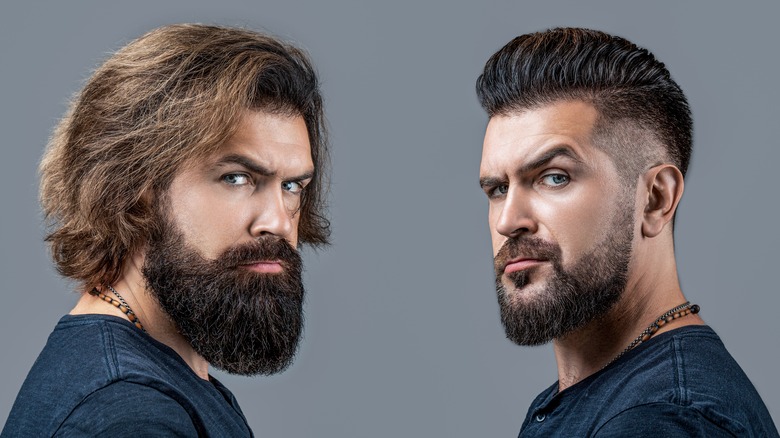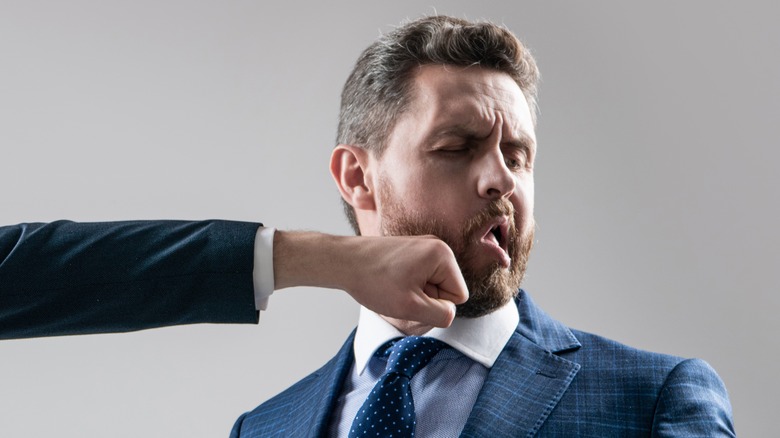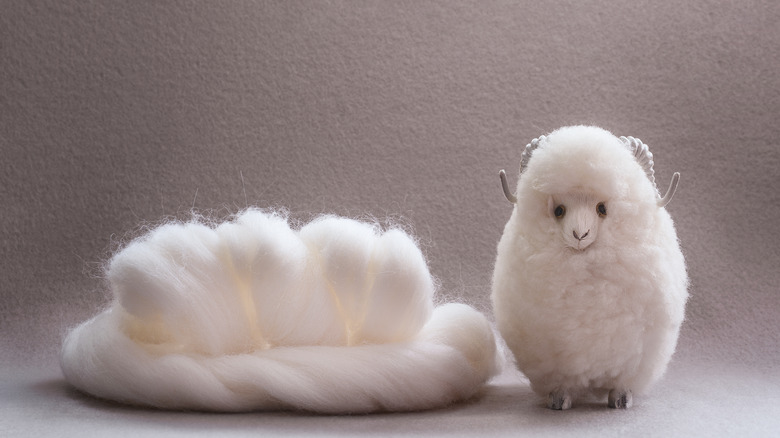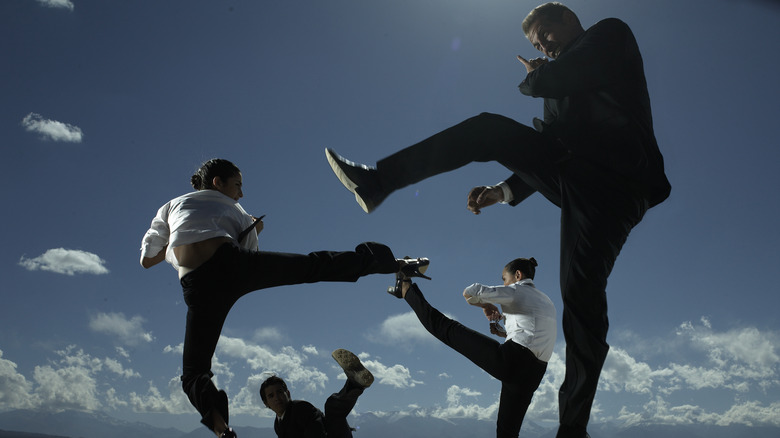The Bizarre Theory Explaining Why Men Evolved Beards
Beards come in as many flavors as there are dudes. We've got your tangled mountain man variety, your carpet-the-throat variety, your wispy puff variety, your dense shrub variety, and many more. Long has humanity wondered: Why go full beard? Do beards make men more attractive? Can they really be kept clean? Are they more of a nuisance than anything? Do you really need that swank beard oil, bro? And perhaps most pertinently of all: Why do they even exist?
Folks might equate thick growths of facial follicles with an abundance of sex hormones like testosterone, and they'd be right. Specifically, beard growth is stimulated by dihydrotestosterone (DHT), as Science Focus says, which is produced by testosterone. Like all sex hormones, DHT exists in women, but in lesser quantities. As for beard fullness, it comes down to genetics, as the Cleveland Clinic explains. Hair gets thicker during puberty, but even by early adulthood a beard might not assume its final form. As for patchy beards, it might be luck of the genetic draw or a medical condition called alopecia areata, which causes the immune system to attack its own hair follicles.
This is all well and good, and explains the biology of beard growth. It doesn't, however, explain why the males of the species evolved to have beards to begin with. Are beards like peacock feathers and meant to distinguish potential mates? Are they signs of post-pubescent fertility? Or did they evolve to protect men's faces from fists?
Grow that furry face shield
That's right: Early human men might have been getting punched in the face so much that survival of the fittest favored follicular jaw shields. This very simple and decently ridiculous idea was explored in a study published in the journal Integrative Organismal Biology in 2020. The article's name says it all: "Impact Protection Potential of Mammalian Hair: Testing the Pugilism Hypothesis for the Evolution of Human Facial Hair." "The pugilism hypothesis" is exactly what is sounds like: Why get punched with a hairless face when hair can absorb the impact?
Even though this idea sounds more like a semi-drunk conversation at a bar between bro-friends, researchers went to the lengths of testing it in a controlled environment. Using an Instron Dynatup 8250 — an actual weight impact testing machine — they dropped a piston-like metal cylinder onto fluffy daubs of wool placed on a metal plate. Before you start crying that wool doesn't sprout from human cheeks, the researchers said, "It was not practical to obtain fully bearded skin samples from human cadavers." Very true. Besides, it wouldn't be ethical to go around punching live humans in the name of science or walloping them across the jaw with metal cylinders. Wool was also a good choice because "the volume of follicles in our fleece samples did approximate the volume of full beards, which is unlikely to be true for the pelts of most other species."
Furred, not sheared or plucked
No research is needed to tell people that metal plates covered in wool take less damage than those not covered in wool. However, researchers in the current experiment used different compositions of wool to see which one absorbed impact the best. Or more accurately, as the study in Integrative Organismal Biology says, they used three different sheep pelts: plucked, sheared, and furred. These pelts resembled three types of human beards: clean-shaven, groomed, and wild man, respectively. The plucked condition had all the hair and roots removed, the sheared condition kept the roots and growth out to 0.5 centimeters, and the furred condition let the wool billow out to 8 centimeters long.
Unshockingly, the furred condition fared the best when struck. As the article says, "The results of this study indicate that hair is indeed capable of significantly reducing the force of impact from a blunt strike and absorbing energy," continuing, "If the same is true for human facial hair, then having a full beard may help protect vulnerable regions of the facial skeleton from damaging strikes, such as the jaw. Presumably, full beards also reduce injury, laceration, and contusion to the skin and muscle of the face."
That last point about protecting from lacerations is key. After all, what guarantee is there that a fight would involve only punching? Folks can scratch, bite, strangle, grapple, etc., all of which seem more likely in an ancient life-or-death situation than a clean punch across the cheek.
Evolutionary advantages
As the current study in Integrative Organismal Biology says, more research is needed to delve into the specifics of how beards might prove advantageous in a fight. Different people have different compositions of beards, after all. Some men grow tight, curly beards that look totally different from the hair on their head. Some facial hair is rougher, some softer, some more wiry, some smoother, some denser, some sparser, some grows down to the Adam's apple, some doesn't, some swirls, some grows straight, and so on. Different types of facial hair might be more advantageous than others in different situations. At least, they might have been more useful in the distant past. The study admits that beards aren't all that effective in developed, stylized fighting forays like mixed martial arts (MMA). After all, human hand-to-hand combat and weapons have long since outstripped any widespread, meaningful protection that hair might provide.
Then again, as the study says, the idea of hair protecting the face from injury does fit well with other evolutionary purposes for beards, like "high masculinity, social dominance, and behavioral aggressiveness." In other words, beards wouldn't have evolved just to keep the face protected, but in tandem with a whole bunch of other reasons that all worked together to make an ancient dude look intimidating, powerful, dangerous, etc. In the end it would be impossible to "prove" whether or not this is true, although amongst animals like lions, manes do provide some degree of overall protection in male-vs-male showdowns.



